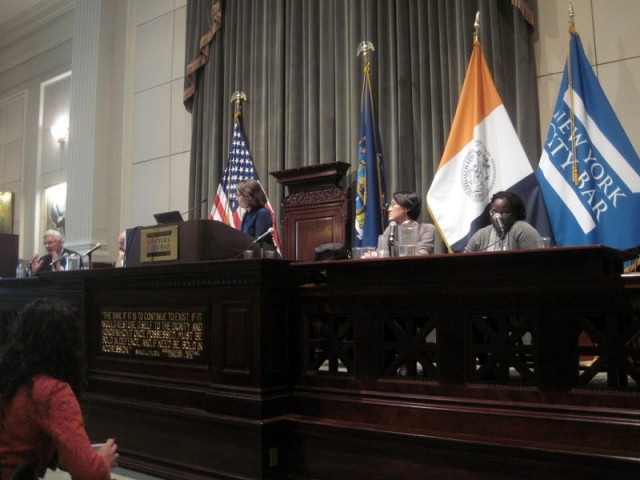
The New York City Bar recently hosted a conference focused on Recovery, Adaptation, Mitigation, and Planning, or RAMP, one of the many urban planning ideas developed in response to Hurricane Sandy’s impact on the city. RAMP is an initiative of the Pratt Institute, which is focusing on public programs to address the issues of a changing climate. The City Bar conference panels grappled with the anticipated problems of social inclusion, finance, housing, infrastructure, and equity, and made clear the challenge of financing an equitable future, both for large scale infrastructure investments and for adding resiliency to individual buildings.
How can society finance and rebuild a coastal city facing climate change? How can risk be measured in detail, and improvements assessed fairly? Can the market force of insurance be brought into play in an equitable way?
Farmers facing an uncertain weather future now have the Climate Corporation, a predictive firm built by two ex-Google engineers, which combines big data with climate models for future warming and provides more precise and useful crop insurance against extreme weather events. The Climate Corporation was just bought by Monsanto in a sign that corporate agriculture now recognizes the risks, and potential business models, in a rapidly shifting climate system. After the billions of dollars of damage caused by Hurricane Sandy, property insurance has a similar push to improve its methods and technology.
[pullquote align=”left”]How can society finance and rebuild a coastal city facing climate change?[/pullquote]There are obstacles to acquiring funding for adaptation upgrades, because loans favor a short return on investment. A project investing in resilience for climate change has a timetable further into the life of a building. Compounding the challenge, the insurance industry lacks a model that details the “certainty of benefits” for the various potential improvements. This gap in measurement takes time to resolve, as the insurance industry updates its models with data on property damage from past weather events to form a more accurate picture of future risk and the benefits of resilient infrastructure.
Another possibility for financing investments in resilience is the return of Limited Dividend Corporations (LDC), an idea from the 1930’s, meaning a private company that takes on specific development responsibilities and limitations in exchange for certain benefits.
In the 1970’s Massachusetts created a new version of the LDC statute, renamed as an Urban Redevelopment Corporation (URC). The difference between LDCs and URCs is that the scope of eligible activities is widened beyond the original objective of low income housing. This statute gained attention from developers in Massachusetts, and the model could provide incentive for private capital to invest in New York City resiliency projects.
[pullquote align=”right”]Farmers now have a high tech tool to guide their investments; should developers in cities?[/pullquote]Not all projects can be funded by private capital. Building equitably and resiliently is not supported by many of the current funding mechanisms, which may need an overhaul to meet the investment demands of the future.
Other major sources of funding are general obligation bonds, highly rated but politically difficult to approve since they come as a tax guarantee, and Community Development Block grants from the Department of Housing and Urban Development, which cover disaster recovery assistance as well as community housing for low to moderate income housing, but are not unlimited.
Public-private partnerships the most logical are with nonprofits who are able to get funding through programs such as the Social Innovation fund. These programs offer funding mechanisms with rigorous criteria, which is good, however in times of crisis they don’t offer enough flexibility. Lastly for-profit companies are strange bedfellows for the government since profit and public good are often vastly different goals. To counter this problem paradigm shifts such as LDCs or other incentives must be carefully tailored and evaluated to insure that they benefit the public good.
The largest problems noted during the conference came from the difficulty in measuring the benefits of resilient and equitable projects. The obsession with measuring outcomes is nothing new, but in the case of non-financial benefits there exists a strong incentive to sacrifice some of the bottom line. This is the first conference from the City Bar’s task force on legal issues of climate adaptation, chaired by Stephan L. Kass. Their goal, as stated by President Carey R. Dunne, is to look at the “financing mechanisms and legal reforms necessary to help cities and nations undertake the investments needed…” Both the City Bar and Pratt are seeking public input on how to finance an equitable and resilient future: join the conversation on Twitter via #rampfinancingnyc.
Notable also is that the City Bar, founded in 1870 in part to clean up a corrupt judicial system in the era of Boss Tweed, shows an active interest in the City’s future as New York faces the peril of climate change. From the Bar’s President’s letter of June, 2013, on the organization’s recommendations for the new Mayor:
Several of the City Bar’s recommendations underscore the importance of New York’s policies in setting an example for the nation and even the world. Climate change is one such area, with the report providing ways for the incoming Mayor to encourage and incentivize City residents and commuters to reduce their carbon footprint. The report also asks the Mayor to support energy efficiency and renewable energy, accelerate the work of the Green Codes Task Force, and affirm his or her commitment to long-term PlaNYC goals. A focus on environmental justice would help mitigate Superstorm Sandy’s disproportionate impacts on disadvantaged communities, while taking steps to enforce mandatory evacuations and implement “reverse 911 calls” would help prevent casualties in the next storm.